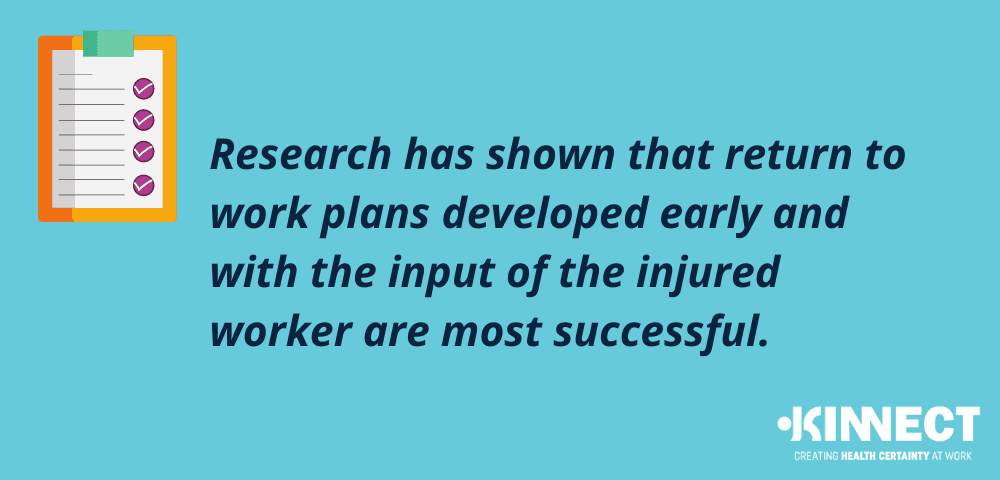A return to work plan is designed and implemented when a worker sustains a work-related injury. The document details the rehabilitation goals and objectives and outlines the steps involved to achieve the rehabilitation goals; including the organisation of services, treatment and support required. Return to work plans also detail the expectations for the worker and employer, providing clear guidance to the management and progression of the program.
Return to work plans differ from suitable duties plan; however, the two are often both used in planning an injured employee’s return to work.
Determining whether a return to work plan is required
Assigned Case Managers will consider a number of factors before determining whether a rehabilitation and return to work plan should be implemented. This includes taking into account the severity of the injury, the worker’s limits for undertaking work duties and if evidence implying a potential re-injury in the workplace. Case Managers also determine whether there is inconsistent medical information regarding the worker’s capacity for duties, work environment factors (e.g. psychosocial health of the workplace) and risk factors for poor or delayed return to work outcomes.
Considerations also include:
- Whether symptoms of an injury appeared over time;
- Absenteeism – particularly several unplanned absences; and
- Coexisting injuries or history of a similar/previous injury.

Developing a return to work plan
A worker’s rehabilitation and return to work plan is coordinated by the regulatory workers’ compensation body in collaboration and consultation with the injured/ill worker, the employer and the treating health professional/s. Research has shown that plans developed early and with the input of the injured worker are most successful.
Role of the injured worker
The attitude and mental health of the worker plays a significant role in the success of a return to work program. Committed and consulted workers tend to have an earlier and more successful return and assimilation back into the workplace. The Case Manager will provide the worker with the opportunity to consider and discuss the rehabilitation plan with their families, general practitioner and others.
Role of the Case Manager
The worker’s Case Manager is responsible for ensuring the development and documentation of the return to work plan in collaboration with the worker, treating doctor and workplace rehabilitation provider (if applicable). The Case Manager is also required to review the draft and signing the determination and signature sections. Case Managers will, in consultation with all involved parties, establish the communication plan throughout the return to work process; with who, when and by which methods communication will occur.
Role of the employer
Throughout the return to work process, the employer will have a number of different tasks to perform, in order to execute their duty of care and to meet their legal obligation under the model WHS law. For the development of the return to work plan, it is important the employer helps the worker identify suitable or alternative duties until, when possible, the employee can return to their pre-injury role. Sourcing modified duties can improve the health and recovery outcomes of the injured/ill employee, in addition to reducing the business’ associated burdens and costs.
Return to work plans vary on a case-by-case basis, however, all plans will include:
- Worker’s personal details;
- Assigned Rehabilitation Case Manager;
- Worker’s support contact;
- Supervisor and workplace rehabilitation provider (if required);
- Return to work goals – specific, measurable, achievable, realistic, timely (SMART);
- Steps involved for return to work or to find suitable employment for the employee;
- Plan review dates; and
- Signature section for the worker, return to work coordinator, treating medical practitioner and supervisor.
Suitable Duties Plans
A suitable duties plan is frequently developed as part of the return to work planning process. These plans, also known as ‘light duties plans’ or ‘alternative duties plans’ are comprehensive lists collating possible meaningful duties that the injured worker can perform without risk of aggravation or reinjury. Suitable duties plans are used as a pathway to recovery while injuries heal and the employee works their way to returning to their pre-injury duties, where possible.
How KINNECT can help
KINNECT is a national injury management and occupational rehabilitation services provider that has been delivering successful, durable and timely returns to work since 1996. We will work closely with the injured worker, the employer, the insurer and any treating health professionals to develop the right rehabilitation program for you to help get your worker back to work.
KINNECT’s return to work plans are tailored to the company and worker’s specific requirements and account for all aspects of the role, injury and current medical advice. Our challenge is to find the best solution to support the worker assimilating back into your company’s workplace and processes in a safe and timely manner.
For more information, please see here.
References
Comcare, Return to work



